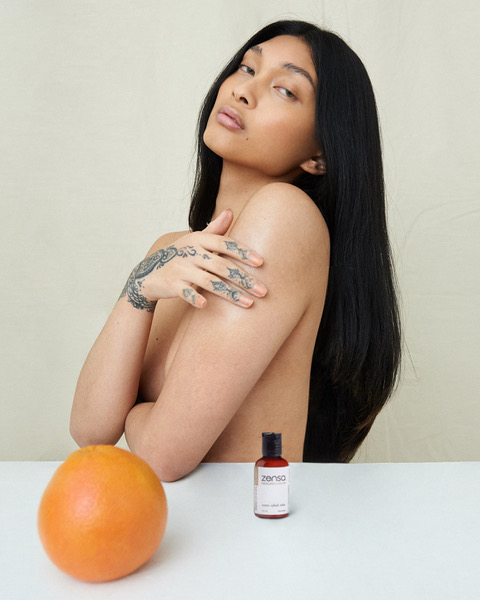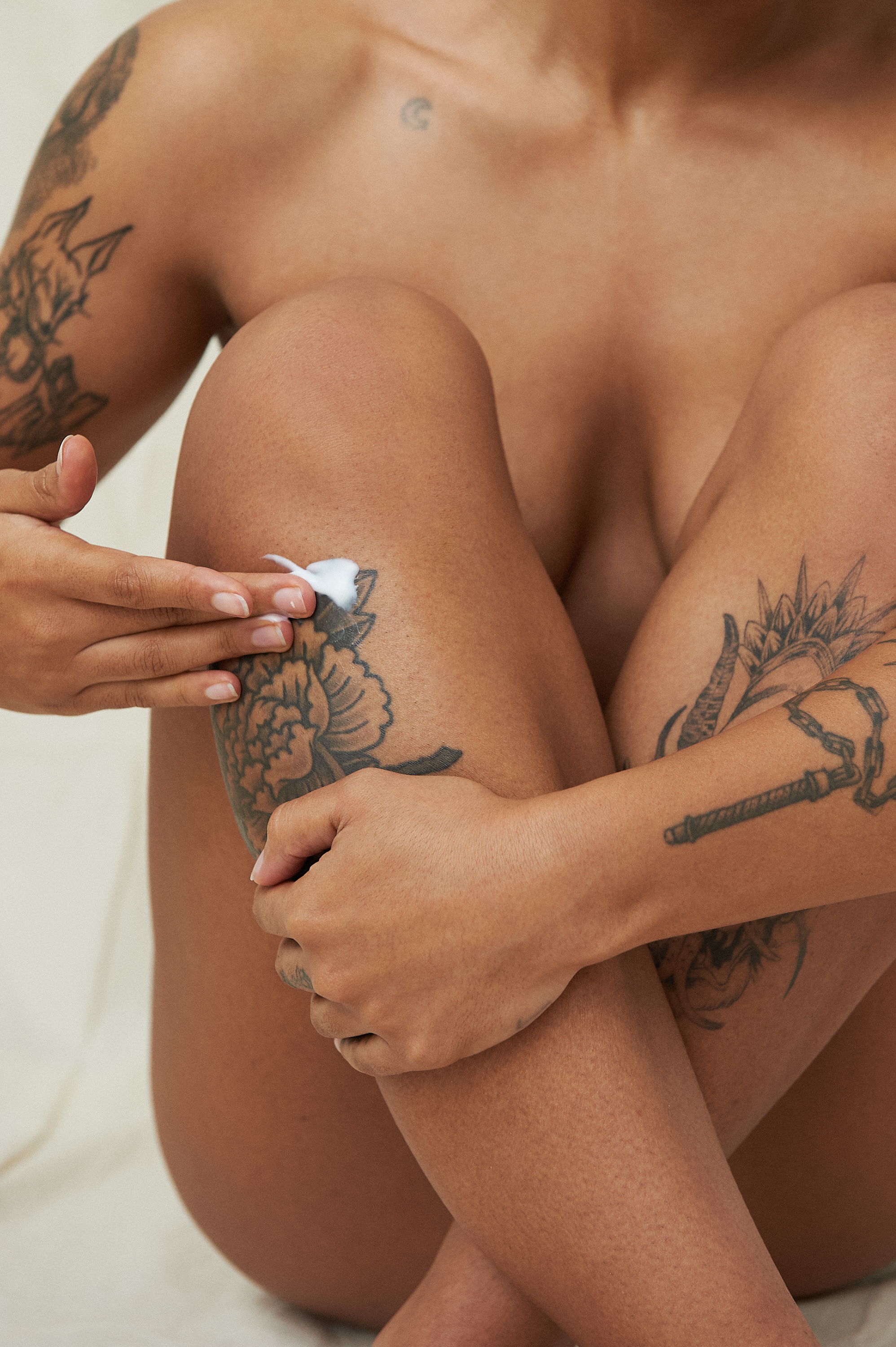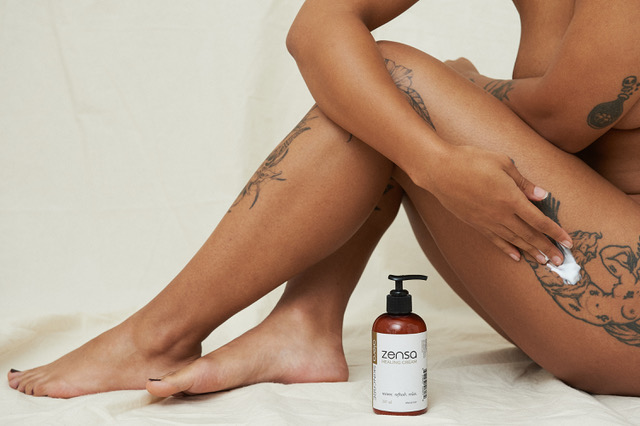6 Easy Habits To Prevent A Tattoo From Fading
6 Easy Habits To Prevent A Tattoo From Fading
Tattoos eternalize your experiences and bring them to the surface. To preserve the design’s colourful details, here’s how to prolong your tattoo’s vibrancy and keep it from fading away.
Premature tattoo fade prevention begins before arriving at the studio and starts with finding a highly-skilled artist in your area. Experts will ensure that the ink is injected into both the epidermis (top skin layer) and deep into the dermis (the middle layer of your skin), so the colour’s saturation remains more resilient as the wound – or tattoo – heals and a new skin layer forms.
Right after the tattoo gun leaves your skin, the ink immediately creates an open wound on your skin and triggers your body’s immune response. This will make your tattoo appear the sharpest it will ever look. During the healing process, some fading is inevitable, as the skin and the tattoo design will unify towards a speedy recovery. This means proper aftercare is the number one priority. Following your artist’s aftercare directions to a T is vital to protect the design’s integrity.
Other fading-potential factors include the tattoo’s placement on the body and ink pigment selection. High friction tattoo placements are more susceptible to fading quickly. Darker pigment shades have better-staying power over time than their lighter-hued counterparts. Daily wellness habits also can make years of difference in your tattoo’s sharpness and signs of wear.
Here are some of the simple habits to effectively preserve your tattoo ink and keep it looking new.
Stay Consistent With Your Aftercare Routine

As the adage goes: Prevention is the best medicine. Tattoo artists stress how crucial it is to maintain a consistent, thorough aftercare routine and implement a gentle cleansing and hydrating routine in days and weeks following your inking session.
Establishing a gentle and attentive daily care routine is pivotal for the tattoo’s final look. In the immediate days after receiving a fresh tattoo, the skin is most prone to irritation, inflammation and infection. These conditions can lead to high levels of discomfort and poor skin health. These side effects also leave you vulnerable to long-term consequences, including permanent scarring and damage to the design’s integrity.
Wash the tattoo with antimicrobial soap, pat it dry and follow up with a hydrating balm. At the same time, allow the design to breathe. Refrain from rubbing and exfoliating cleaning practices and avoid constricting the area with tight-fitting clothing. These habits also fend off a potential breeding ground for infection, which can result in immediate fading. Listen and follow your artist’s directions carefully for the best results.
Within a week after receiving your tattoo, you will notice the upper layers of the skin will form a scab and start peeling shortly. At this part of the healing process, the design’s initial vibrancy often fades very slightly.
Surface-level hydration takes priority at this stage. According to a 1962 research study, moist wounds heal approximately 50% more quickly than drier ones and play a significant role in reducing infection, scarring and achieving better cosmetic results. A 2009 clinical trial further confirmed these findings and prove that proper moisturizing significantly reduces wound inflammation and scarring.
It’s important to remember that tattoos take approximately six months to heal fully. Even after this period, it is vital to have a life-long fade-prevention plan in place to keep your tattoo appearing fresh.
Pamper Your Skin

While simple creams are better than dry healing, tattoo-specific moisturizing products are uniquely crafted to prevent skin ailments and maintain the design’s sharp aesthetic. When shopping, seek out products specifically formulated with ingredients to enhance your tattoo’s vibrancy and relieve any signs of inflammation or irritated skin texture.
Zensa Healing Cream combines calendula and grapefruit seed to nourish your skin and accelerate the healing process. It also contains sunflower seed oil, known for its natural brightening properties and shea butter and cucumber extracts to calm the skin. These natural ingredients combined enhance the ink’s saturation and smooth the skin to allow the design to take center stage. Use this product twice a day throughout the entire initial recovery period for optimal results.
Apply Sunscreen Regularly

Unprotected sun exposure will negatively affect your tattoo’s resiliency. UV rays are a leading cause of discolouration, decreased collagen production and skin wrinkling. The tattoo ink is infused into your dermis layer, which means that any changes in your skin texture will give the tattoo an uneven appearance and significantly speed up the fading process over time.
Sunscreen is an absolute must for overall skin health and tattoo brightness. Apply it once or several times daily with a product that contains at least 30 SPF for maximum protection. This UV-blocking shield creates a protective barrier to keep ink colours vibrant and your skin glowing, which work together to enhance the tattoo’s design. Sunscreen should be re-applied regularly when possible.
The sun ultimately dehydrates your skin – making moisture an even more vital component of your daily tattoo care routine when you’re spending a lot of time outside.
Keeping your tattoo covered when possible, even while wearing sunscreen, best prevents short-term fading and prolongs the design’s colour saturation. It is particularly important to wear clothing over the inked area when you have a fresh tattoo. Over the first one to three months, limiting the skin’s exposure to direct sunlight is advised to promote proper healing.
Maintain A Healthy Lifestyle

Like the rest of your body, tattoos require regular nourishment to remain in ideal condition.
Your tattoo’s wellness is highly dependent on your skin health, which we know reflects from within. Any vitamin or mineral deficiencies, dehydration and smoking reduce collagen production, cell repair and promote free radical production. Over time, these cycles reduce your skin’s elasticity, resilience towards sun exposure and alter your skin’s texture, which in turn can cause tattoo fading.
Ultimately, eating a nutritious diet with ample amounts of water and refraining from tobacco smoking will enable your tattoo to shine from within and look its best.
As previously discussed, a freshly inked tattoo relies on your immune response to heal effectively. Foods rich in antioxidants and vitamins A, C, D, and E contain infection-fighting properties to boost this bodily function. Make sure to add adequate produce and omega-3 rich foods to your meals to reap the full benefits.
Allow Your Skin To Breathe

While on the topic of skin elasticity, it is worth mentioning how everyday friction, sweating and significant stretching affect how quickly a tattoo can potentially fade.
When selecting your desired tattoo placement, keep in mind that designs in high-friction areas are prone to fade quickly. The rubbing in these areas from everyday movements often leads to over-exfoliation and discolouration. Many of these high-touch areas, including your hands, feet and joints, also have thinner skin layers and will sweat more frequently, which will only accelerate the fading process.
Tattoos will fade more rapidly when constricted and often occurs from wearing tight clothing, a backpack, or sporting activities. Allowing the tattoo to breathe is essential to prevent trapping excess body heat and reduces irritation, too.
While tattoos are permanent, our bodies will nearly inevitably change at some point in our post-inked lives. Weight fluctuations are completely normal and our skin’s elasticity is designed to accommodate these natural changes. Rapid and significant weight loss or gain from pregnancy, bulking or other lifestyle shifts can stretch the skin past its built-in threshold. This process breaks apart the ink molecules in the tattooed region and disperses the pigment, creating a more faded appearance.
Invest In A Touch-Up

Ink touch-ups provide a lift to your current tattoo and are a practical solution for many against fading. However, it is essential to wait until the original tattoo has fully healed before going under the gun again. A grace period of one to six months should be enough time for the skin to repair. Speak to your artist to determine the proper healing timeline for your specific tattoo.
Whether you desire to freshen up your fairly new ink or revive a decade-old design, artists will tailor your enhancements to your timeline with a short upkeep session. These procedures frequently include revitalizing some of the lost pigmentation or adding small details to refresh your existing design.
Investing in high-quality work and adhering to a proper aftercare routine are the best ways to prevent returning to the studio shortly after your initial visit. Some aftereffects, though, are out of your control and might require a prompt revision.
As your tattoo transforms, touch-ups provide a sometimes necessary alternative. This process allows the design to evolve with you and rekindles your affinity for the original ink.
